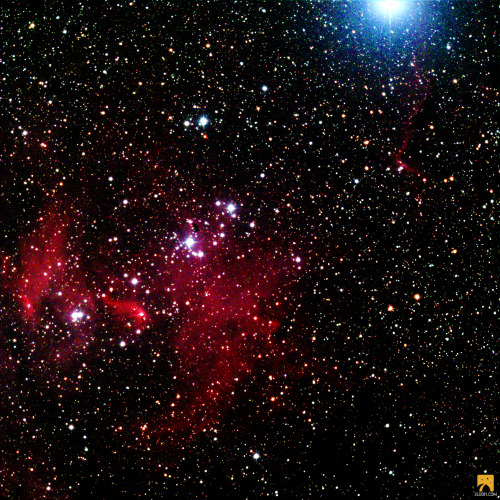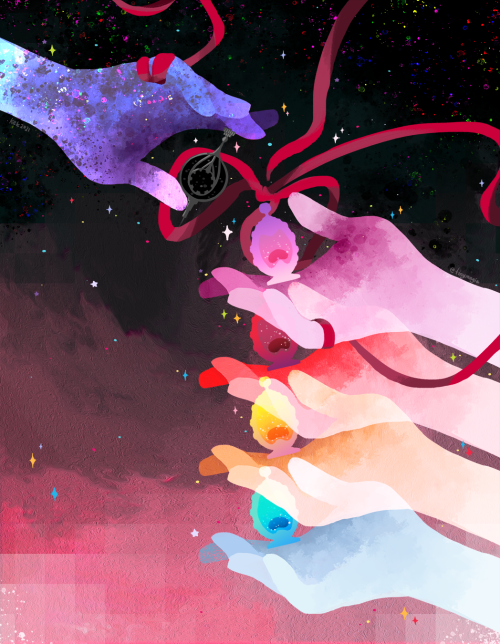This Is The Box Nebula AKA The Little Gem Nebula! 📦 💎 📦 💎 📦💎

This is the Box Nebula AKA The Little Gem Nebula! 📦 💎 📦 💎 📦💎
Although this planetary nebula may look small, it’s around 4 light years across! The unusual shape may be due to its orientation to us… 👀👀👀
Taken by me (Michelle Park) using the Slooh Canary Two telescope on June 19th, 2020 at 00:02 UTC.
More Posts from Mystarypi and Others

This is the Running Chicken Nebula! 🐤🐤🐤
This nebula’s unique name comes from the shape of its brightest region being similar to a running chicken. In the upper right corner, you can see the bright star Lambda Centauri, which gives this nebula a second name: the Lambda Centauri Nebula! 💫💫💫
Taken by me (Michelle Park) using the Slooh Canary Two telescope on February 5th, 2022 at 3:22 UTC.

This is the Eskimo Nebula! ⛄⛄⛄
This nebula is created by the death of a Sun-like star and its strange 2 layered appearance gives it a lot of creative names such as the Clown-Faced Nebula or the Lion Nebula. Even though it looks like the planetary nebula is smooth, the reality is that it has dense filaments of matter all around it! ✨✨✨
Taken by me (Michelle Park) using the Slooh Chile One telescope on December 6th, 2020 at 3:58 UTC.

This is the Black Eye Galaxy! 🌌🌌🌌
The disk of this galaxy vigorously produces stars with its rapid inflow of mass into the incredibly active black hole at the center. An inner disk produces this galaxy’s distinct dust lane that gives it its name! 🌃🌃🌃
Taken by me (Michelle Park) using the Slooh Canary Two telescope on March 7th, 2021 at 4:53 UTC.









It’s Monday!
Collection of the 2019 inspirational eevee series.

Stardust In Aries

This is the Lunar Eclipse of May 15th, 2022! 💖💖💖
As the Earth’s shadow covers the Moon, it appears to disappear into darkness. This is just one of 85 lunar eclipses that will occur in the 21st century. If you missed this one, don’t worry! The next total lunar eclipse will occur on November 8th, 2022. 🌑🌛✨
Taken by me (Michelle Park) using the Slooh Canary One telescope on May 15th, 2022.

This is the Orion Nebula! ✨✨✨
Thought to be a cosmic fire of creation by the Mayans, the Orion Nebula’s bright, vibrant colors come from the massive stars in the open star cluster at the center of the nebula. This star forming region is giving birth to thousands of stars, each of them only a few million years old! 💫💫💫
Taken by me (Michelle Park) using the Slooh Canary Two telescope on March 21st, 2021 at 22:53 UTC.





Puppy galore! 🐶🐾

despite everything, you still love madoka magica (happy 10th anniversary!!)
One of my favorite nebulae ♥♥♥ It looks so beautiful 🥰🥰🥰

NGC 6357: Cathedral to Massive Stars via NASA https://ift.tt/31D4Lqn
How massive can a normal star be? Estimates made from distance, brightness and standard solar models had given one star in the open cluster Pismis 24 over 200 times the mass of our Sun, making it one of the most massive stars known. This star is the brightest object located just above the gas front in the featured image. Close inspection of images taken with the Hubble Space Telescope, however, have shown that Pismis 24-1 derives its brilliant luminosity not from a single star but from three at least. Component stars would still remain near 100 solar masses, making them among the more massive stars currently on record. Toward the bottom of the image, stars are still forming in the associated emission nebula NGC 6357. Appearing perhaps like a Gothic cathedral, energetic stars near the center appear to be breaking out and illuminating a spectacular cocoon.
(Published August 30, 2020)
-
 wakayume liked this · 3 years ago
wakayume liked this · 3 years ago -
 mystarypi reblogged this · 4 years ago
mystarypi reblogged this · 4 years ago -
 maximumgardenbanditcalzone liked this · 4 years ago
maximumgardenbanditcalzone liked this · 4 years ago -
 kimblethimble liked this · 4 years ago
kimblethimble liked this · 4 years ago -
 opalflowersforever liked this · 4 years ago
opalflowersforever liked this · 4 years ago -
 ttauriontherise reblogged this · 4 years ago
ttauriontherise reblogged this · 4 years ago -
 fromthemouthofkings liked this · 4 years ago
fromthemouthofkings liked this · 4 years ago -
 a-royal-hoot reblogged this · 4 years ago
a-royal-hoot reblogged this · 4 years ago -
 2unknown-artists liked this · 4 years ago
2unknown-artists liked this · 4 years ago -
 koinwniopatheia liked this · 4 years ago
koinwniopatheia liked this · 4 years ago -
 starstruckcomicsanimeoperator liked this · 4 years ago
starstruckcomicsanimeoperator liked this · 4 years ago -
 relatiivity liked this · 4 years ago
relatiivity liked this · 4 years ago -
 w3irdoartist liked this · 4 years ago
w3irdoartist liked this · 4 years ago -
 mysticalbeardonutland liked this · 4 years ago
mysticalbeardonutland liked this · 4 years ago -
 nidzz liked this · 4 years ago
nidzz liked this · 4 years ago -
 sugarcane003 liked this · 4 years ago
sugarcane003 liked this · 4 years ago -
 warriorintheworks liked this · 4 years ago
warriorintheworks liked this · 4 years ago -
 automaticdazecycle liked this · 4 years ago
automaticdazecycle liked this · 4 years ago -
 novacortex liked this · 4 years ago
novacortex liked this · 4 years ago -
 myramuffin liked this · 4 years ago
myramuffin liked this · 4 years ago -
 heilyy liked this · 4 years ago
heilyy liked this · 4 years ago -
 honey-sickness reblogged this · 4 years ago
honey-sickness reblogged this · 4 years ago -
 karmanbirchauhan liked this · 4 years ago
karmanbirchauhan liked this · 4 years ago -
 mutedtempest reblogged this · 4 years ago
mutedtempest reblogged this · 4 years ago -
 honey-sickness liked this · 4 years ago
honey-sickness liked this · 4 years ago -
 eurpoastitan liked this · 4 years ago
eurpoastitan liked this · 4 years ago -
 computer-powered-waffles liked this · 4 years ago
computer-powered-waffles liked this · 4 years ago -
 scrumptiousrebelpatrolperson liked this · 4 years ago
scrumptiousrebelpatrolperson liked this · 4 years ago -
 purple-rosa liked this · 4 years ago
purple-rosa liked this · 4 years ago -
 im-just-the-traveler liked this · 4 years ago
im-just-the-traveler liked this · 4 years ago -
 nour-ray liked this · 4 years ago
nour-ray liked this · 4 years ago -
 hergnomieness liked this · 4 years ago
hergnomieness liked this · 4 years ago -
 fuckyeahcelestialthings reblogged this · 4 years ago
fuckyeahcelestialthings reblogged this · 4 years ago -
 hjlphotos liked this · 4 years ago
hjlphotos liked this · 4 years ago -
 tenaciousrascalponyhands liked this · 4 years ago
tenaciousrascalponyhands liked this · 4 years ago -
 void-tiger reblogged this · 4 years ago
void-tiger reblogged this · 4 years ago -
 void-tiger liked this · 4 years ago
void-tiger liked this · 4 years ago -
 itsybitsybookworm liked this · 4 years ago
itsybitsybookworm liked this · 4 years ago -
 blackhoneyandgold reblogged this · 4 years ago
blackhoneyandgold reblogged this · 4 years ago -
 blackhoneyandgold liked this · 4 years ago
blackhoneyandgold liked this · 4 years ago -
 thesignificantowlhootsinthenight liked this · 4 years ago
thesignificantowlhootsinthenight liked this · 4 years ago
